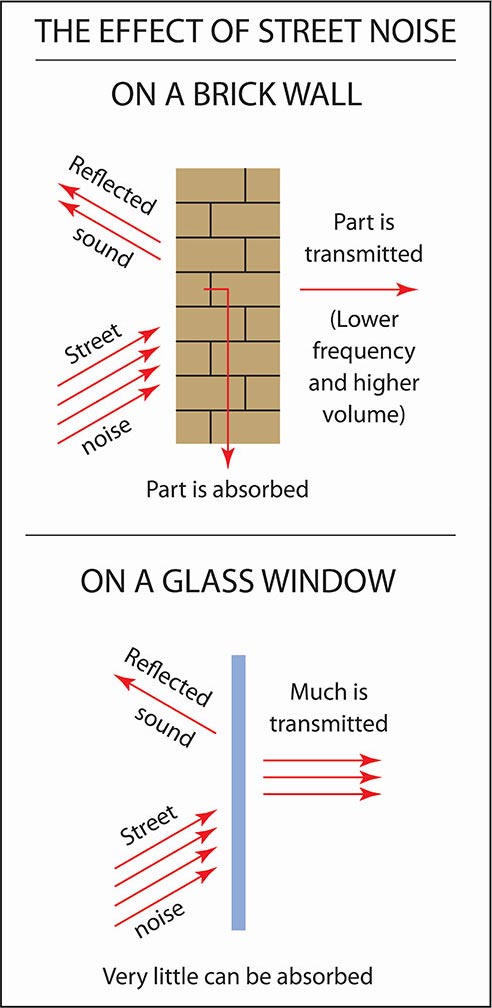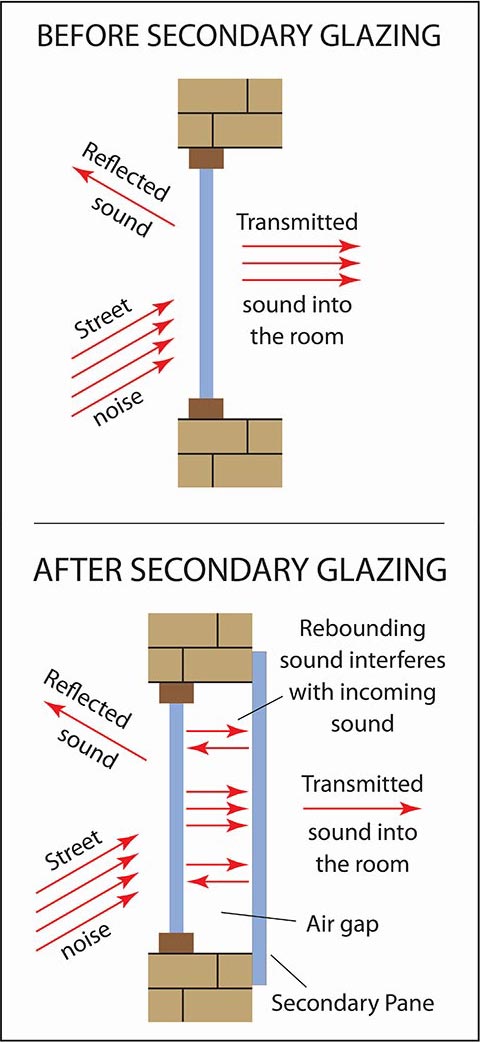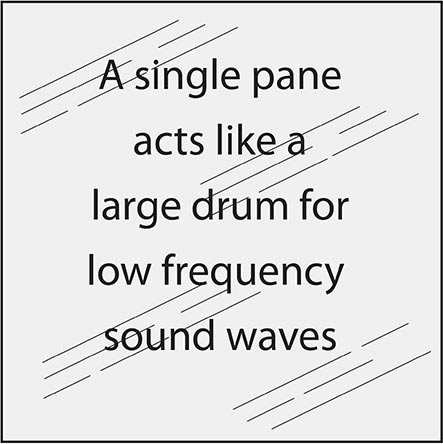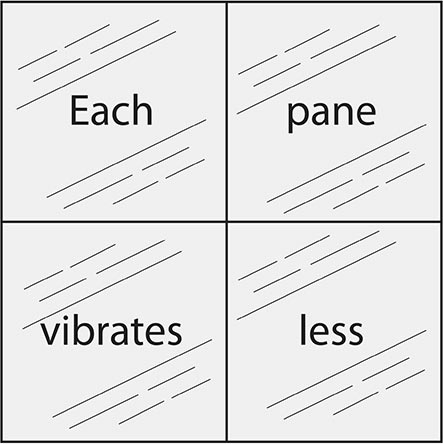Noise Reduction from Secondary Glazing
Customers regularly contact us about how to reduce the amount of outside noise that they hear in their homes and offices, from everyday things such as traffic, barking dogs, loud music and people talking nearby. These noises all have the ability to disturb you at work, leisure or sleep; living with this can be stressful, and spoil the quiet enjoyment of your property that is often taken for granted. So, identifying the problem is fairly easy, but it is not always simple to work out how to tackle it, and what products or methods, from the many available, will work best for your particular situation. We hope that the detailed information on this page will help you.
Sound vibration demonstration video
Because sound vibrates obstacles in its path, causing onward transmission, we decided to use this to visually demonstrate sound in some simple tests. By putting a speaker in a chamber directly below a pane on which there are small plastic pellets, the video alongside shows what happens when the pane vibrates in time to the music.
The video uses the pellets in some comparison tests to illustrate three basic principles:
- the mass of a glazing sheet affects how much it vibrates
- a secondary pane with an air gap reduces onward sound into a room
- a larger air gap with secondary glazing reduces onward sound still further
The speaker chamber and the 4 sided frames providing the air gaps have foam draught excluders on the top and bottom edges, to prevent vibrations in the walls from affecting the sheet above and pellets on it. These draught excluders isolate the pane by dampening (as covered below)
It was useful to film in this way to avoid changes in sound being manipulated by the camera phone we use; like many smartphones it has automatic noise adjustment, which quietens noises it thinks are too loud, and amplifies those it thinks you need to hear more.
What is Sound?
It might be useful to use these definitions:
- Sound is vibrational energy that travels in compression waves from the source, conducted by but dissipating slowly through air, and capable of transmitting through solid structures like walls and windows by vibrating them. This in turn vibrates the air on the opposite side of the structure to create new sound waves of the same frequency
- Noise can be defined as any unwanted sound
- Frequency describes both the length of the sound wave generated and the pitch of the sound. Low frequency = a deep noise that travels in longer waves that are harder to reduce by solid objects as the wave finds them easier to vibrate, hence drum/bass penetrates and shakes the walls more than singing, for example
- Volume describes the amount of energy in the wave. If you hit a drum harder, the sound is louder although the frequency does not change. Loud deep noises are therefore likely to be the most penetrating
- Flanking noise is what penetrates a structure by bypassing it, over or around, or through air gaps like in an open or draughty window
- Mass describes “how much stuff” is in an object, providing resistance to any force. Increasing the thickness of an item increases its mass, so a thick brick wall will vibrate less than a thinner one
- Resonance is the ability of an object to vibrate. A large rigid object is more resonant than an object made up of layers, as these will be harder to vibrate as one as each layer’s vibrations interfere with the others to reduce the overall effect
How does Sound work on solid objects?

Using the common example of traffic noise on a typical busy road, sound waves will be constantly generated and will travel through the air and reach your house. They impact against the walls and windows, and the waves can do these things:
- Reflect; some of the energy bounces off, like an echo. The greater the mass the more energy will be reflected, as the structure will be harder to vibrate, particularly for high frequency waves. The differing masses mean that the walls will reflect a lot more sound than the windows
- Absorb; a very limited amount of energy will be absorbed by the structure, the amount depending on its composition. Elastic materials are more sound absorbent, but of course are generally not used in walls or windows
- Diffuse; irregular surfaces scatter the sound waves, breaking them up into smaller waves with less energy, helping them dissipate quicker. Windows are smooth and rigid so will not diffuse, walls may do so a little. Diffusion is more relevant inside the house where carpets and soft furnishings have a much greater effect – consider the difference between the echos in an empty room and the complete lack in a fully furnished one
- Transmit; any remaining energy will vibrate the walls, if it is powerful enough, and the windows much more easily, causing them to bounce air on the opposite side and re-create the waves. Some sounds will actually penetrate the structure as well, where it is thin, where there are gaps in the window frames (as flanking noise) or the sound is deep and loud enough
Bearing all this in mind, it means that windows are the main acoustic “weakness” in a property, when looking to reduce external noise. Because of this you will get the biggest improvements by insulating the windows first, and the quickest way to do this is to add secondary glazing to them.
Ways of reducing the noise for windows

- Stop flanking noise; by sealing gaps in the outer window with draught excluders. This can be a very quick and inexpensive way to improve the insulation of a window frame. For a window that you never intend to use, you can also consider “painting it shut” as this will also close hard-to-reach gaps.
- Add mass; thicker panes do make a difference to sound penetration, but they can still vibrate, so this is not a complete solution. Double glazing, despite the air gap, tends to act as one structure in terms of vibration, but a structure in two parts with an air gap will reduce sound more than a single structure of the same mass. It is worth noting that adding mass using thicker materials will almost certainly add cost to a glazing project.
- De-coupling; if you have two panes that are not physically linked, and an air gap in between, the outer pane will vibrate and transmit an ongoing wave which will hit the inner pane and partly reflect. This will interfere with the vibration of the outer pane and the air in the gap acts as a dampener, canceling more sound. The bigger the air gap, the better – 100mm+ is recommended (or e.g. the full depth of your window cavity). However, you will still benefit from a reduction in sound even if the gap is smaller, just not as much
- Dampening; In addition to or if you can’t de-couple the inner window, you can reduce the vibrations transmitted by using an elastic material between them, to disrupt and absorb the vibrations.
In the images alongside, the “After” picture shows the secondary pane using as much of the window cavity as it can to provide a deep air gap. The inner pane is as de-coupled as it can be as well, as it is not attached to the outer window frame, so it will only be subject to vibrations passed on by the wall structure. We have not shown it, but some of the Easyfix secondary glazing systems will also provide some dampening by separating the inner pane using flexible PVC (e.g. our Clipglaze system) or foam adhesive tape (e.g. all the Magnetglaze systems and Trackglaze).
Other factors with windows
There are other factors that affect a window’s ability to transmit sound:
- Large glass panes transmit noise more than a collection of smaller panes, because the bigger they are the more they will vibrate, like a drum. In the image alongside, the single pane of glass will be more vulnerable to noise, even though the quartered pane arrangement relies on each pane being airtight to be more efficient.
- Metal window frames are more efficient transmitters of noise than wood or plastic as they are much more resonant, steel in particular. This is a pity because they can be a very attractive period feature of a house, albeit cold to the touch. As an illustration of how easily metal structures conduct noise from vibration, stand on a station platform and wait for an approaching train, which you will often hear from rail buzz before it comes into view, especially if the train is traveling at high speed.
- Glass panes have more density and mass than plastic glazing, but plastic better absorbs and dampens sound. The effect on sound can be similar, just achieved differently.
- Window fittings need to be taken into account when insulating as handles, blinds and shutters may need to be accommodated by secondary glazing.
- Listed and conservation area buildings usually have restrictions on altering the outward appearance, i.e. only to replace the windows with new ones of identical appearance. By adding secondary glazing however, insulation can be transformed for noise and heat, and be either invisible or hard to see from outside – you should always check what the local restrictions are before commencing installation.



